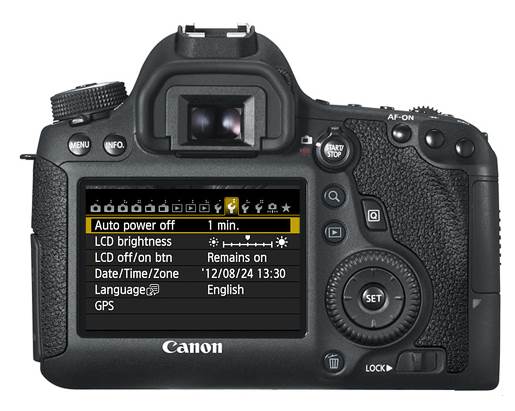Filming mode
Like all former and latter Canon DSLRs
including 60D and 5D Mark III, EOS 6D can record 1,080p HD videos at 30, 25 and
24fps. If you want 50 or 60p you will need to pass 720p resolution and there’s
also a 640x480 mode at 50 or 60fps. Notice that unlike Mark III, the resolution
of the horizontal sensor is not perfectly divisible by 1920, so some measures
being not an integer can be replace with the consequence of increasing the risk
of noise.
As EOS 5D Mark III, 6D provides internal
frame (ALL-i) or inter-frame (IPB) compression format, the former reaches
higher quality and edit footage easily, though at thirstier data rate. In my
test the IPB 1080p footage consumes about 240MB/ minute and the ALL-i 1080p one
is about 660MB/minute. Canon recommends using a card with at least 20MB/s write
speed for shooting at All-I mode. 6D also inherits the SMTP time code cohesion
of 5D Mark III, allowing easier synchronization in post-production, and making
it the good B camera for shooting projects with Mark III.

The thing you can’t get over is a straight
output through HDMI to connect an external recorder. While composing you always
get a white focusing frame as a minimum, and once shooting there’s a red circle
used to pop up on the top red corner and in both cases, the photo itself is
framed with the thick black border, so the operating area actually has the size
of 1,620x910 pixels. To be fair, the new ALL-I internal-frame compression
option has reduced the necessity or desire for an external recorder, but some
filmmakers still flavor the flexibility of a straight HDMI output more. To ones
who use the outer screen, the 1,620x910-pixel image area though HDMI when
recording at least will offer a more detailed photo than Mark II, making
focusing and pulling easier.
If you’re on the consumer-end of the
film-making world, you won’t enjoy auto focusing continuously while shooting
with EOS 6D. This keeps the elusive goal for the traditional DSLR. Nikon may
have its Full time AF mode, but it’s a “solution” that you want to disable
immediately. For 6D and D600, as their more-expensive siblings, basically
remains the manual focusing for filming once you start to turn. Both can
perform single refocus when shooting, but this takes a few seconds. So, it’s
not ideal unless you can cut it off later. If you want AF to be continuous when
shooting, you should take a look at a mirrorless CSC mode or a SLT of Sony.

Remote
Shooting mode in the iPhone app, complete with exposure controls at the bottom
EOS 6D has an available single micro,
therefore, as above, Nikon D600, if you want to record the stereo you will need
to connect an external micro through the 3.5mm jack. D600 has taken a further
step than a headphone socket for you to monitor the recording sound.
D600 also has the ability to send an
uncompressed, non-graphics signal though its HDMI port; however, the All-I
return option of 6D makes this reduce an issue. Based on the balance, I think
with its DX crop mode, the uncompressed HDMI output, pre-integrated stereo
micro and headphone socket, D600 has the ability of a movie camera rather than
a 6D. At least at this level, Nikon has turned upside down the long-standing
dominance of Canon in this field.
Unless contrast points out that I soot this
clip and other clip samples which are shown here in 1080p25 IPB mode of EOS 6D.
The quality looks good and stabilization works effectively when ironing all
wobbles except for a short mid-pan area. The zoom ring on the 105mm lens is
very smooth, but even so, it’s hard to achieve a good result when holding the
camera with hands.
I made 2 mistakes when shooting videos with
EOS 6D that is placed on a bracket and stabilization is off. First is the focus
setting by the aligned AF point on a bout at average distance, supposed that
the image depth will be enough for everything to reach infinity. As you can
see, at the end of the magnified point, the details are a bit washed out.
25-105mm f4L has distance meter and I should have tested it. Or one external
screen may highlight a problem that doesn’t obviously show up when playing back
on the 3in screen of 6D. The second mistake is the failure when attaching the
lens hood which has been reduced, though it may be unable to eliminate flare
when the camera facing directly to the sun. Besides that, the quality is
excellent. As in the previous clip, the noise of the wind infiltrates a lot.
The solution is to use an outer micro with wind shield to enable the Wind
filter.

I
made 2 mistakes when shooting videos with EOS 6D that is placed on a bracket
and stabilization is off.
This is the repetition of the previous
clip, this time shooting in 1080p25 All-I highest-quality compressing mode of
EOS 6D. All-I consumes about 11MB/s or 660MB/minute of the footage compared to
the 4MB/s of 240MB/minute for IPB mode.

This
is the repetition of the previous clip, this time shooting in 1080p25 All-I
highest-quality compressing mode of EOS 6D.
EOS 6D lacks continuous AF mode, but if you
look at the clip of Nikon D600 in Full-time Servo AF mode, you will understand
that this is not a huge loss. The AF contrast defining system rummaging back
and forth in the supported DSLRs is actually for watching, if you need AF for
filming, the best bet should be one of the compact mirrorless system camera or
a Sony SLT. Here, 6D works effectively for exposure and white balance in this
lowlight mixture settings and the clip doesn’t clutter.

EOS
6D lacks continuous AF mode